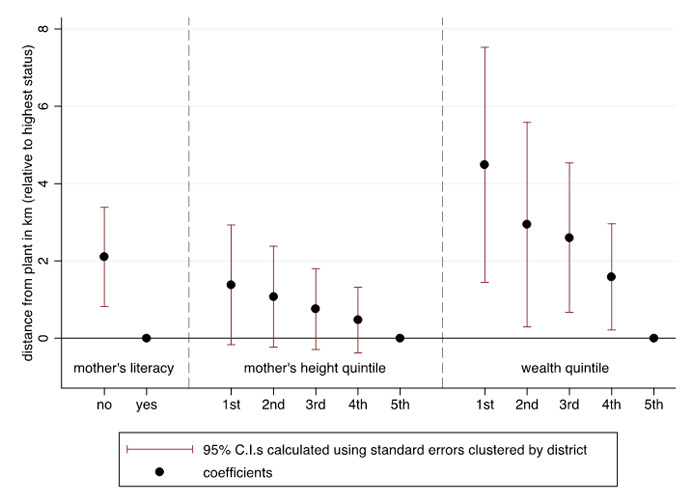In recent years, electricity generation from coal has rapidly increased in India. This article explores the consequences of India’s large and ongoing coal plant expansion on child health and human capital. It finds that children who are born exposed to a median-sized coal plant are shorter than those who are born with no coal plant exposure. Supporting air pollution as a channel, effects are larger among children living closer to coal plants.
In recent years, electricity generation from coal has rapidly increased in India. It now represents about two-thirds of India’s total electricity-generating capacity. To meet growing demand for power, the Ministry of Power plans to add another 100 gigawatts in coal capacity by 2027, about a 50% increase from its current level.1 Meeting growing electricity demand is important, but the costs of coal are far greater than the expense of extracting it from the ground, transporting it, and turning it into energy. The pollution associated with burning coal for electricity negatively affects the health of people living near coal plants, and these health costs are important to quantify and consider in policy decisions.
In recent research (Vyas 2019), I explore the consequences of India’s large and ongoing coal plant expansion on child health and human capital. I find that children who are born exposed to a median-sized coal plant (the 50th percentile plant in terms of coal plant capacity) are shorter than those who are born with no coal plant exposure.
Strategy: variation in local coal capacity within place, across cohorts of children
I use a detailed dataset on coal plants which contains the precise location, commissioning date, and generating capacity, for every new generation unit that has gone online in India. I link geocoded villages and urban areas surveyed in India's recent National Family Health Survey (NFHS) to the dataset on coal plants. I classify a place surveyed in the NFHS as exposed to a coal plant if it is within 50 km of that plant. Between 2010 and 2016 (the period I study), coal plant capacity more than doubled in India. I exploit variation within place, across cohorts who differed in exposure to local coal capacity. My strategy compares children born in the same village when exposure to coal plant capacity is different.
Child height as a measure of child health
As a measure of child health, I use child height, an indicator of net nutrition in early life. Child height is an important economic variable because taller children perform better on cognitive achievement tests, stay in school longer, and end up earning higher wages as adults. How could exposure to air pollution make children shorter? One possible biological mechanism linking air pollution to child height operates through pregnant women's health. Exposure to particulate matter may cause infections in pregnant women that exacerbate pulmonary or placental inflammation, and hinder the exchange of oxygen and nutrients between the placenta and the foetus. This may affect foetal growth, birth weight, and child height. A second potential mechanism operates through the effect of air pollution on the respiratory health of young children. Air pollution increases the incidence of respiratory infections among children, and the immune response brought about to fight disease plausibly diverts scarce nutrients away from physical development.
Children born exposed to local coal capacity are shorter than unexposed children born in the same place
I find that an additional median-sized coal plant (in terms of capacity) is associated with a height deficit of about 0.1 standard deviations.2 To put this effect into perspective, it is about one-third of the within place height gap between children of illiterate versus literate mothers, and about two-thirds of the height gap between children in India and children in sub-Saharan Africa.
If coal plant capacity affects the heights of children through air pollution, the effect on child height should be larger (in absolute terms) for children living closer to a coal plant than for children living farther away. Figure 1 shows the effect of coal capacity exposure, at different distances, on child height. Except for the first distance bin, the effect of coal plant capacity becomes closer to zero as distance from the coal plant increases. Changes in local coal plant capacity also predict changes in local air pollution, another pattern that is consistent with the mechanism of air pollution.
Figure 1. Effect of coal capacity on height attenuates with distance

Note: Numbers in parentheses are the fraction of the sample that have positive capacity within the distance bin. 95% C.I. (confidence interval) is a way of expressing uncertainty about estimated effects. Specifically, it means that if we were to repeat the sampling method over and over with new samples, we would expect the true effect to fall within the interval estimate 95% of the time.
Rich households tend to live closer to coal plants than poor households
Figure 2 shows that children with illiterate and shorter mothers, and children living in poorer households, on average, live farther away from coal plants when compared to children whose parents are higher in socioeconomic status. This is an interesting pattern that is unique from other parts of the world, where poorer households are more likely to live in places that have lower locational quality and higher air pollution. This also suggests that there are important and complex distributional consequences from coal plant expansions in India.
Figure 2. Children from lower socio-economic households live farther from coal plants
Effects cannot be explained by other simultaneous changes
Can these patterns be explained by other changes that were happening at the same time that coal plant capacity was changing? For example, what if the expansion in coal plants brought more labour market opportunities and made households living nearby richer? Wealth probably has an effect on child height too. If this were happening, my results could be biased. However, a few tests suggest that this is not happening. Changes in coal plant capacity do not similarly predict other birth characteristics related to child height and household wealth, nor do they predict changes in light output at night, an indicator of electricity coverage and economic development. This may be because the electricity generated from these plants is used to power areas both near and far, facilitated by India's large centralised grid.
What if coal plants are located in special places that are trending differently compared to places that do not get coal plants? Two further tests suggest that this is unlikely. Places near new coal plants do not have differential height trends compared to places that never end up near coal plants. Similarly, capacity additions sometimes occurred through expansions to existing plants and sometimes through entirely new coal plants, and the main effects hold when using only the variation from expansions.
Finally, what if poorer households moved near coal plants because these areas became more affordable due to a degradation in locational quality? This is unlikely to bias the results because migration of women and children in India is very rare. The effects are not explained by rich households migrating away from coal plants, or poor households migrating towards them.
While these tests cannot directly rule out the possibility that coal capacity expansions are spuriously picking up impacts on child height through other unobserved changes, they suggest that the main results are not driven by other channels, and support a causal interpretation.
These effects are large and meaningful
Height is highly correlated, at the population level, with early-life mortality, because survivors' growth is scarred by early-life disease. In the NFHS, a district where children are 0.1 standard deviations shorter would be expected, on average, to have an infant mortality that is larger by about 9 infant deaths per 1,000 live births. This difference is approximately equal to two times Canada's overall infant mortality rate.
The nutrition that contributes to physical growth also contributes to cognitive development, educational attainment, and earnings later in life. Children exposed to an extra median-sized coal plant are expected to be less likely to read by about 0.5 percentage points.3 In terms of earnings, if the height deficits from coal plants observed here persists to adulthood, and the adult height-earnings slope remains constant, those exposed to an additional median-sized coal plant at birth would be expected to have hourly earnings that are lower by between 0.5% to 1.5%.4
The health and human capital costs of coal are important for policy
Exposure to air pollution from coal plants has meaningful and enduring negative consequences for India's economy. The impacts on child health and human capital documented in this study make coal far costlier than the expense of extracting coal from the ground, transporting it, and turning it into energy. At the very least, these social costs should be part of any policy debate on expanding electricity generation to meet India’s energy needs.
Notes:
- The National Electricity Plan (2018) states that 47,855 MW of coal-based capacity are under different stages of construction, and are likely to materialise during 2017-2022. On top of this amount, 6,445 MW more coal-based capacity is expected to be required in the 2017-2022 period, and 46,420 MW more is expected to be required in the 2022-2027 period.
- Standard deviation is a measure that is used to quantify the amount of variation or dispersion of a set of values from the mean value (average) of that set.
- This calculation uses the child height-achievement gradient documented by Spears (2012).
- This back-of-the-envelope calculation is based on estimates of the adult earnings-height slope in various developing countries documented by Vogl (2014), Glick and Sahn (1998), Thomas and Strauss (1997), Schultz (2003), and Haddad and Bouis (1991).
Further Reading
- Case, Anne and Christina Paxson (2008), “Stature and status: Height, ability, and labour market outcomes”, Journal of Political Economy, 116(3):499-532.
- Clay, K, J Lewis and E Severnini (2016), ‘Canary in a coal mine: Infant mortality, property values, and tradeo_s associated with mid-20th century air pollution’, National Bureau of Economic Research.
- Currie, Janet, Joshua Graff Zivin, Jamie Mullins and Matthew Neidell (2014), “What do we know about short-and long-term effects of early-life exposure to pollution?”, Annual Review of Resource Economics, 6(1):217-247.
- Glick, Peter and David E Sahn (1998), "Health and productivity in a heterogeneous urban labour market", Applied Economics, 30(2):203-216.
- Gupta, Aashish and Dean Spears (2017), “Health externalities of India's expansion of coal plants: Evidence from a national panel of 40,000 households”, Journal of Environmental Economics and Management, 86:262-276.
- Haddad, Lawrence J and E Howarth Bouis (1991), "The impact of nutritional status on agricultural productivity: wage evidence from the Philippines", Oxford bulletin of economics and statistics, 53(1):45-68.
- Schultz, Paul (2003), "Wage rentals for reproducible human capital: evidence from Ghana and the Ivory Coast", Economics & Human Biology, 1(3):331-366.
- Spears, Dean, Sagnik Dey, Sourangsu Chowdhury, Noah Scovronick, Sangita Vyas, and Joshua Apte (2019), “The association of early-life exposure to ambient PM 2.5 and later-childhood height-for-age in India: an observational study”, Environmental Health, 18(1):62.
- Thomas, Duncan and John Strauss (1997), "Health and wages: Evidence on men and women in urban Brazil", Journal of econometrics, 77(1):159-185.
- Vogl, Tom S (2014), "Height, skills, and labor market outcomes in Mexico", Journal of Development Economics, 107:84-96.
- Vyas, S (2019), ‘The child health impacts of coal: Evidence from India’s coal expansion’. Available at SSRN.




 28 February, 2020
28 February, 2020 





Comments will be held for moderation. Your contact information will not be made public.